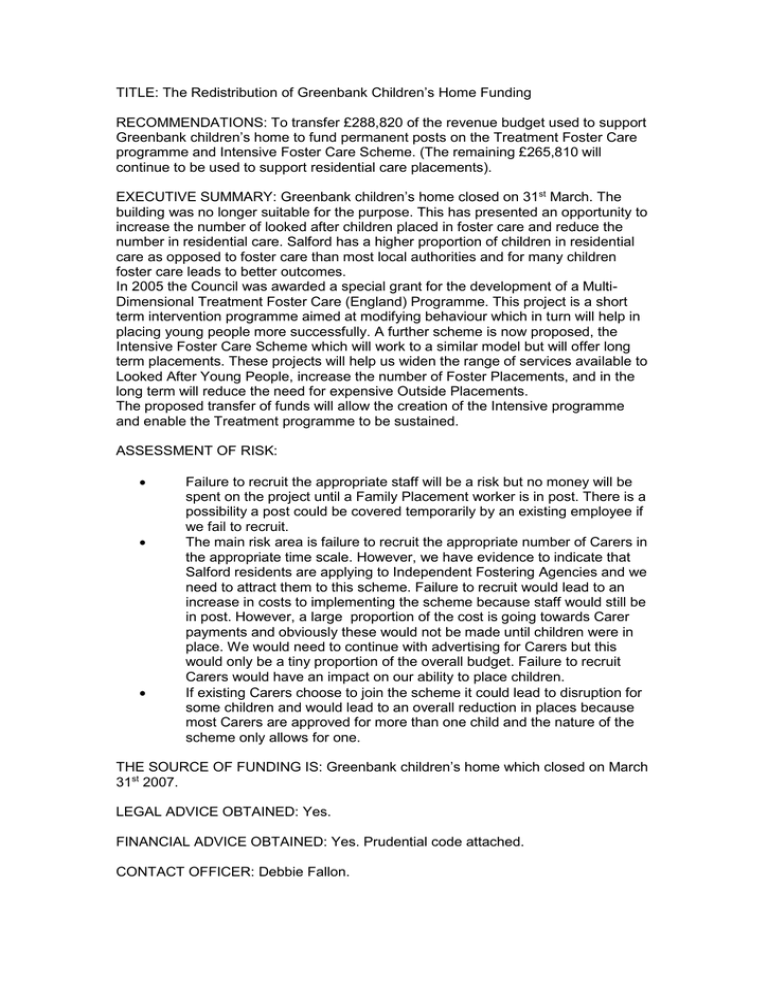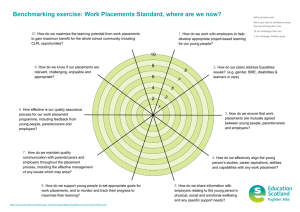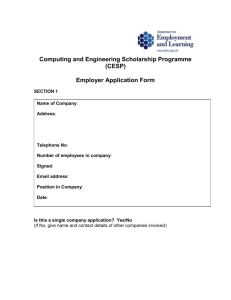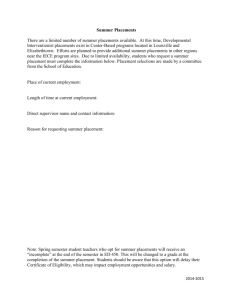TITLE: The Redistribution of Greenbank Children’s Home Funding
advertisement

TITLE: The Redistribution of Greenbank Children’s Home Funding RECOMMENDATIONS: To transfer £288,820 of the revenue budget used to support Greenbank children’s home to fund permanent posts on the Treatment Foster Care programme and Intensive Foster Care Scheme. (The remaining £265,810 will continue to be used to support residential care placements). EXECUTIVE SUMMARY: Greenbank children’s home closed on 31st March. The building was no longer suitable for the purpose. This has presented an opportunity to increase the number of looked after children placed in foster care and reduce the number in residential care. Salford has a higher proportion of children in residential care as opposed to foster care than most local authorities and for many children foster care leads to better outcomes. In 2005 the Council was awarded a special grant for the development of a MultiDimensional Treatment Foster Care (England) Programme. This project is a short term intervention programme aimed at modifying behaviour which in turn will help in placing young people more successfully. A further scheme is now proposed, the Intensive Foster Care Scheme which will work to a similar model but will offer long term placements. These projects will help us widen the range of services available to Looked After Young People, increase the number of Foster Placements, and in the long term will reduce the need for expensive Outside Placements. The proposed transfer of funds will allow the creation of the Intensive programme and enable the Treatment programme to be sustained. ASSESSMENT OF RISK: Failure to recruit the appropriate staff will be a risk but no money will be spent on the project until a Family Placement worker is in post. There is a possibility a post could be covered temporarily by an existing employee if we fail to recruit. The main risk area is failure to recruit the appropriate number of Carers in the appropriate time scale. However, we have evidence to indicate that Salford residents are applying to Independent Fostering Agencies and we need to attract them to this scheme. Failure to recruit would lead to an increase in costs to implementing the scheme because staff would still be in post. However, a large proportion of the cost is going towards Carer payments and obviously these would not be made until children were in place. We would need to continue with advertising for Carers but this would only be a tiny proportion of the overall budget. Failure to recruit Carers would have an impact on our ability to place children. If existing Carers choose to join the scheme it could lead to disruption for some children and would lead to an overall reduction in places because most Carers are approved for more than one child and the nature of the scheme only allows for one. THE SOURCE OF FUNDING IS: Greenbank children’s home which closed on March 31st 2007. LEGAL ADVICE OBTAINED: Yes. FINANCIAL ADVICE OBTAINED: Yes. Prudential code attached. CONTACT OFFICER: Debbie Fallon. WARD(S) TO WHICH REPORT RELATE(S): All wards. KEY COUNCIL POLICIES: DETAILS: The project will be the development of two specialist Foster Care Schemes, initially for 20 children, known as Intensive Foster Care Scheme. Scheme 1 Medium to long-term provision for under 12’s. (10 places) Those children eligible to enter the project will; Be aged 5-11 years at point of referral. Have complex and severe, emotional or psychological difficulties. Be displaying severe levels of challenging/anti social behaviour. Likely to have had long standing involvement with a range of services. Be experiencing attachment disorders. The purpose of the scheme will be to; Provide specialist foster care to children aged 5-11 years. Provide medium to long-term placements helping children to attach. Ensure children have appropriate access to health services, (particularly mental health) and Education Services. To stabilise children who may have experienced a number of placements. To help children understand and make sense of their life experiences. To prepare children for long-term placement. Scheme 2 Medium to long-term provision for over 12’s (10 places) Those children entering the project will; Be aged 12-15 at point of referral. Have complex and severe, emotional or psychological difficulties. Be displaying severe levels of challenging anti social behaviour, which poses risk to themselves or others. Likely to have had long standing involvement with a range of services including the Criminal Justice Service. Will be experiencing attachment disorders. Likely to have had a number of placement moves The purpose of the scheme will be to; Provide specialist foster care to children aged 12-15 who may not otherwise have the opportunity to live in a family. Provide a move on placement for young people progressing from the Treatment Foster Care Project and the Support Unit, offering a structured and supportive environment where young people can build on the skills they have developed in the previous placement. Ensure young people have a stable placement until they are ready to leave care. Ensure young people have appropriate access to Health Services, (particularly mental health) and Educational Services, with opportunities to develop independence skills and to progress onto further Education, Training or Employment. Foster Carers The scheme will aim to attract Carers who are looking at fostering as an alternative to paid employment. Financial reimbursement will be important because the scheme and the demands of the children will necessitate a high level of skill, experience and determination and very close working with professionals in a number of agencies. At least one of the carers in each family will have no other occupation and fostering will be their primary focus. We are aware there has been an increasing number of Salford residents applying to Independent Fostering Agencies in recent years, 18 in total this year, and it is these people we are wanting to attract. It is a requirement of the scheme that Foster Carers; Will have no other child under the age of 12 or other dependants living at home. Will have previous experience of working with or caring for children with complex needs and challenging behaviour. Will provide a warm, consistent and structured living environment. Will have the ability to demonstrate competency at level 5 of the Payment for skills scheme. Are willing and able to achieve level 3 NVQ in Caring for Children and young people. Reason For Proposal Nationally it is recognised that there are difficulties in securing appropriate placements for children and young people who are looked after. There is a particular difficulty in securing effective placements for young people with challenging and anti-social behaviour and complex needs. Such young people are frequently placed with Foster Carers who are not equipped to manage their behaviour or meet their needs. Consequently, such young people are often then placed in a sequence of out-of–area residential placements which do not improve their outcomes. Scheme 1 The Family Placement Team in Salford regularly runs recruitment campaigns to recruit new Carers. The number of children requiring placement however always outweighs the number of available Carers. This scheme would allow us, for the first time, to attract a different type of person to fostering. The allowance paid would be the equivalent to the wage of a Childcare Worker. We therefore hope to attract people who are looking at fostering as an alternative to an existing job/career and who will already be experienced in childcare. We would also be in a better position to compete for Carers with the Independent Fostering Agencies (IFA’s) who are able to pay much higher allowances than have traditionally been paid to Local Authority Carers. Over the last 4 years we have seen a steady increase in the numbers of out of authority residential placements for under 12’s. In 2003/04 there were 14, 2004/05 17 and 2005/06 20. In Salford we developed two children’s homes in partnership with voluntary organisations to provide a service for this age group when no suitable Foster Carer could be found. Both homes ran successfully until early 2005 when one of the partners withdrew at short notice requiring a home to close. This was after a series of failed attempts to recruit and train staff to the required level. This has increased the difficulties in finding suitable placements for this age group. Research shows Children tend to experience better outcomes when placed in foster care as opposed to residential care, and for this age group foster care is usually the preferred option. However, compared to our PI comparator Family Group we tend to fair worse than other authorities on the number of under 10 year olds in foster Placement. In 2004/05 95% 0f our under 10’s were in foster care compared to an average of 97.9% in our comparator group and 98% all England. Scheme 2 We pay more for IFA placements but have no evidence they are more successful than those with our own carers. Usually the most challenging teenagers are placed in out of Authority residential placements. These are expensive and research shows that outcomes for the majority of young people are not good. In 2006/2007 we placed 18 young people aged 12-18 in out of Authority placements amounting to a spend of £1,214,870. Altogether we had 40 children in the age group in placement at some point at a cost of £4,430.578. A Specialist-Fostering Scheme would offer these young people a real alternative to residential care, will be more cost effective and will allow them to remain in Salford. Research shows outcomes for Looked After Children are better in Foster Care and better when placed close to home. Salford has won a bid from the Department for Children, Schools & Families to run another specialist scheme known as “Treatment Foster Care”. The criteria for this is very rigid and there is a very formal treatment methodology. It is a short-term intervention so it is crucial we develop ‘move on’ provision for young people progressing through the scheme, or an alternative for those not meeting the criteria. Last year we opened a new residential provision in Salford called a Support Unit. The purpose of this unit is to work with a small number of children who are challenging their placements and where they have either broken down or are likely to break down. The unit brings the young people back to their local area and offers a period of stability while they are re-assessed. Again the intervention is short term and so ‘move on’ services will be necessary. Therefore we are looking to meet future need through fostering as opposed to residential provision. A recommendation from the report of the Salford Scrutiny Committee Sub Group on Corporate Parenting was to “Explore ways of sustaining, developing and increasing the number of Foster Carers, particularly in light of competition from the private sector” A high level of support services have been developed in Salford for looked after children including a specialist CAMHS service, STARLAC, a Health Needs Coordinator, A Leisure Co-ordinator and a Care and Education Team. This scheme would utilise these support services and enable them to further develop where necessary. Funding Closure of Greenbank Children’s Home provides a revenue source, which could actually result in a shift in balance of resources toward Foster Care. Project Costs (Including placement costs) 07/08 Running Costs Proposed Savings Total 08/09 09/10 Ongoing £99,120 £436,420 £687,710 £870,730 None £475,800 £817,000 £1,033,000 -£99,120 +£39,380 +£129,290 +£162,270 Budget available from Greenbank is £318,700 This will cover costs in the first year and will go some way to subsidise the project in the second and third year if the project is slower to develop than anticipated. When the project becomes self financing (possibly in the 2nd year based on these targets) the Greenbank funding could be transferred to pump prime a new project. Unit Cost The Project will cost £870,734 a year to run at 06/07 costs (including placement costs which will be redirected from existing placements). Occupancy and Costs 100% (20 children) £840 95% (19 children) £880 85% (17children) £990 The desired occupancy level would be around 85% allowing for placements choice. However, as placements are to be medium – long term once placements are used there will not be a great deal of movement. Placements will be planned which means as a discharge is planned it is likely that an admission will also be being planned so leaving very short periods when there is a vacancy. Therefore it is likely that once the scheme is up and running occupancy will be at around 95% giving a unit cost of £880. This makes it a viable alternative to both residential (In-house and external) and IFA placements. Once the project is up and running further work will take place to establish how the scheme can be expanded. This may result in a lower unit cost but at some point additional staff would be required to support the scheme so increasing the cost again. Round Number of Children Return from Agency Foster Placement Move from Existing Placement 5 Return from O.P Residential Placement 2 1 1 2 2 5 2 1 2 3 5 1 1 3 4 5 1 1 3 Total 20 6 4 10 Savings Average cost of O.P Average cost of Agency = = £2,270 £1,560 per week (single placement) No cost attributed to internal moves from existing placement (Internal Foster Care placement or In-house or partnership residential placement). Risks Failure to recruit the appropriate staff will be a risk but no money will be spent on the project until a Family Placement worker is in post. There is a possibility a post could be covered temporarily by an existing employee if we fail to recruit. The main risk area is failure to recruit the appropriate number of Carers in the appropriate time scale. However, we have evidence to indicate that Salford residents are applying to Independent Fostering Agencies and we need to attract them to this scheme. Failure to recruit would lead to an increase in costs to implementing the scheme because staff would still be in post. However, a large proportion of the cost is going towards Carer payments and obviously these would not be made until children were in place. We would need to continue with advertising for Carers but this would only be a tiny proportion of the overall budget. Failure to recruit Carers would have an impact on our ability to place children. If existing Carers choose to join the scheme it could lead to disruption for some children and would lead to an overall reduction in places because most Carers are approved for more than one child and the nature of the scheme only allows for one.




